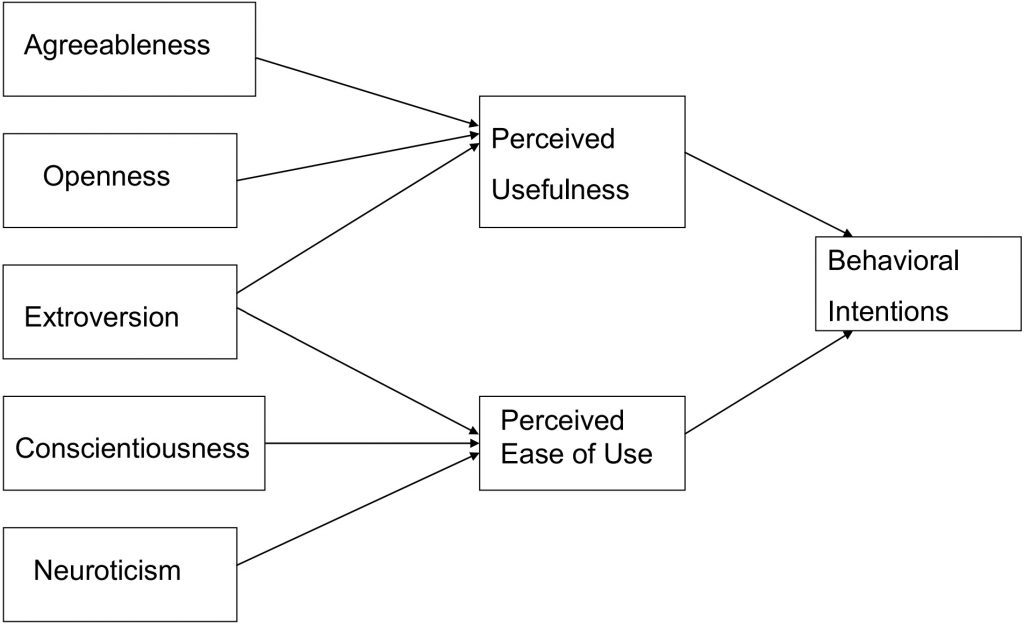
Personality & technical knowledge management systems research: Theoretical framework [Personality & TKMS series]
This is part 15 of a series of articles featuring edited portions of Dr. Maureen Sullivan’s PhD dissertation.
Quantifying how the personality types of users relates to their acceptance or non-acceptance of technical knowledge management systems was studied by determining correlations between personality types, as measured by the five-factor model (FFM), and the acceptance of technical knowledge management systems (TKMSs), as measured by the technology acceptance model (TAM).
The personality and technical knowledge management systems study expanded the research conducted by Lin and Ong1, whose study explored and proposed a model to connect personality traits to information system usage through the introduction of the five-factor personality model into the information system continuance model, and the research conducted by Devaraj, Easley, and Crant2.
Lin and Ong used questionnaires to gather data on the usage of a system at a Taiwanese University. Similarly, Devaraj, Easley, and Crant performed a study to determine how the TAM constructs (subjective norms, intention to use, and usefulness) are affected by the personality traits of the FFM. Moreover, “quantitative case studies rely heavily on questionnaires of key constructs, frequency counts of observed phenomena, or surveys (whether through interview or questionnaire) of critical respondents in a given case” 3. Consequently, the personality and technical knowledge management systems study used the survey method to gather data from users of technical knowledge management systems.
The personality and technical knowledge management systems study broadens the unified theory of acceptance and use of technology (UTAUT)4 by proposing that the personality factors in the five-factor model (FFM) are positively correlated to the behavioral intention to use and accept TKMSs. Figure 1 illustrates the research model for this study5.

The UTAUT was formulated by combining and eliminating some elements of prior technology acceptance models. For instance, the UTAUT describes four principle constructs of the intention to use and the usage of IT: facilitating conditions (UTFC), effort expectancy (UTEE), performance expectancy (UTPE), and social influences (UTSI; defined in Table 1) and blends the elements of eight different models of acceptance. The perceived usefulness construct shown in Figure 1 encompasses the UTAUT constructs of performance expectancy and the behavioral intentions to use the system. The behavioral intentions to use the system are also related to the attitude toward using technology, self-efficacy, and anxiety. The perceived ease of use shown in Figure 1 encompasses the UTAUT construct of effort expectancy. Accordingly, the UTAUT is a more comprehensive model and formed the base model of the personality and technical knowledge management systems study.

The accumulated prior research on personality measures suggests that almost all personality measures and specific traits can be categorized under the five-factor model of personality (called the big five)6. Costa and McCrae7 asserted that these five constructs can be generalizable across many cultures and have been found to be fairly stable over time. The five traits are defined in Table 2.

Next edition: Personality & technical knowledge management systems research: Research design.
References:
- Lin, M. Y., & Ong, C. S. (2010). Understanding information systems continuance intention: A five-factor model of personality perspective. PACIS 2010 Proceedings, Taipei, Taiwan. ↩
- Devaraj, S., Easley, R. F., & Crant, M. J. (2008). How does personality matter? relating the five-factor model to technology acceptance and use. Information Systems Research, 19(1), 93-105. doi:10.1287/isre.1070.0153 ↩
- Swanson, R. A., & Holton, E. F. (2005). Research in organizations: Foundations and methods of inquiry. San Francisco: Berrett-Koehler Publishers. ↩
- Venkatesh, V., Morris, M. G., Davis, G. B., & Davis, F. D. (2003). User acceptance of information technology: Toward a unified view. MIS Quarterly, 27(3), 425-478. ↩
- Rosen, P. A. & Kluemper, D. H. (2008). Proceedings of the Fourteenth Americas Conference on Information Systems, p. 3. ↩
- Barrick, M. R., & Mount, M. K. (1991). The big five personality dimensions and job performance: A meta-analysis. Personnel Psychology, 44(1), 1-26. doi:10.1111/j.1744-6570.1991.tb00688.x ↩
- Costa, P. T., & McCrae, R. R. (1988). Personality in adulthood: A six-year longitudinal study of self-reports and spouse ratings on the NEO personality inventory. Journal of Personality and Social Psychology, 54(5), 853-863. doi:10.1037/0022-3514.54.5.853 ↩





